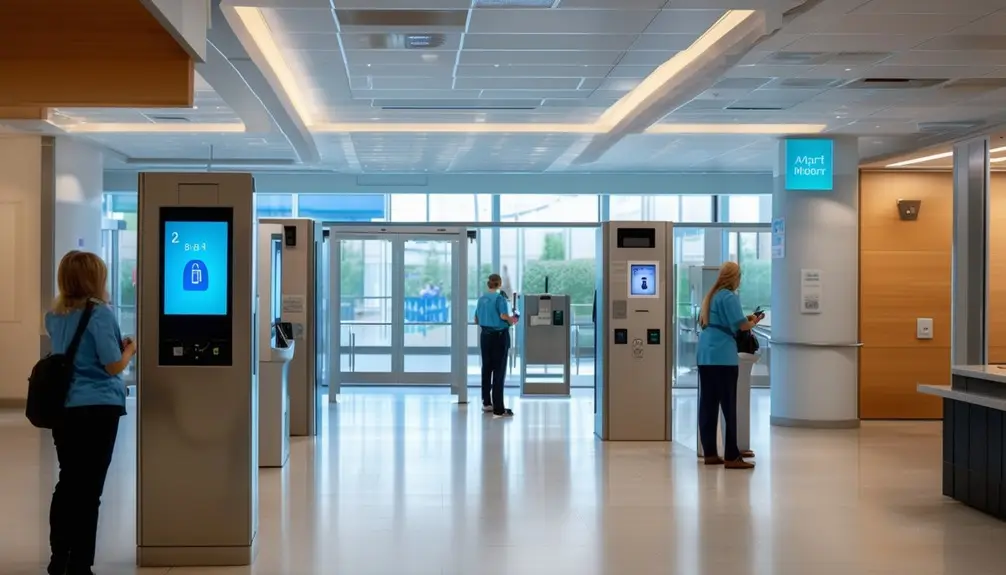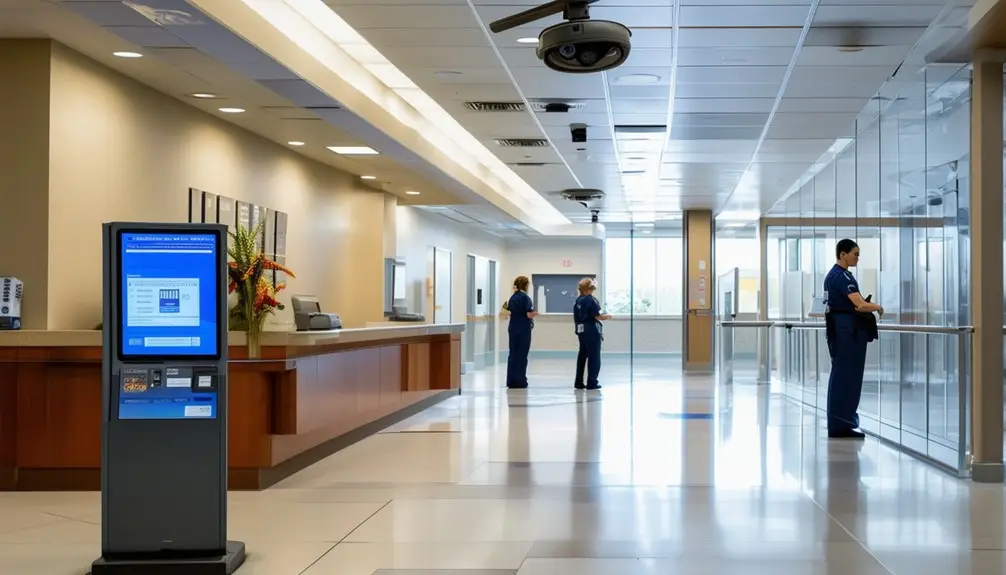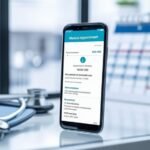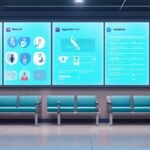Implement automated visitor sign-in systems to streamline hospital operations, reduce wait times, and enhance security. These systems offer rapid check-ins, instant badge printing, and real-time visitor tracking. Customizable forms guarantee compliance with hospital regulations while enhancing visitor experiences. Integrated access control automates permissions, freeing staff for critical tasks and boosting emergency response. Real-time data tracking supports efficient contact tracing and emergency readiness. You'll find that adopting these systems improves both safety and operational efficiency, letting you focus on patient care. For an in-depth understanding of these benefits, keep exploring the detailed insights.
Table of Contents
ToggleKey Takeaways
- Automated systems drastically reduce wait times for visitor check-ins.
- Real-time visitor tracking enhances security and operational efficiency.
- Immediate badge printing ensures quick identification and access control.
- Customizable visitor forms meet specific hospital requirements and compliance.
- Integration with access control systems centralizes and streamlines visitor management.
Key Features of Visitor Management
Leveraging quick sign-in processes, visitor management systems in hospitals streamline registration and enhance efficiency. These systems enable you to sign in swiftly, reducing wait times and supporting a smoother entry process. Upon sign-in, the system immediately prints visitor badges, allowing for easy identification and enhancing security within the hospital premises.
Real-time visitor tracking is another critical feature. With a visitor management system, hospitals can monitor and manage visitor flow efficiently. This tracking capability ensures that the hospital staff can account for all visitors, making it easier to locate individuals when needed and maintain a secure environment.
Customizable visitor forms are designed to cater to your hospital's specific requirements. These forms can collect essential information tailored to various departments, ensuring that all necessary data is captured during registration. This customization improves the overall visitor experience and aligns with the hospital's operational needs.
Automated visitor notifications provide real-time updates to hospital staff about visitor arrivals and departures. This feature supports that staff members are always informed and can prepare accordingly, improving overall coordination and response times.
Benefits of Automated Systems
Automated visitor sign-in systems drastically reduce wait times, making hospital check-ins more efficient and secure. By capturing visitor information quickly, including photos and badges, these systems guarantee a streamlined process. Real-time data allows for instant badge printing and continuous visitor tracking, which enhances security and operational flow.
With automated visitor management systems, you can customize forms and notifications to fit specific needs, thereby improving the visitor experience and overall hospital safety. These systems leverage real-time data to deliver immediate insights into visitor activities, enabling hospital staff to respond promptly to any security concerns.
Implementing automated systems means hospitals benefit from enhanced security and data analytics. The ability to collect and analyze visitor data leads to better resource allocation and informed decision-making. In turn, this helps in optimizing hospital operations and ensuring a safer environment for patients and staff alike.
Automated systems don't just streamline processes; they also provide a layer of accountability. Real-time data tracking means you can monitor visitor movements, thereby reducing unauthorized access and potential security breaches. Overall, automated visitor sign-in systems are a pivotal addition to modern hospital management systems, delivering efficiency and security through advanced data utilization.
Importance of Visitor Tracking
Visitor tracking greatly enhances emergency readiness in hospitals by providing real-time data on who is in the facility at any given moment. This capability is vital during health crises for efficient contact tracing, ensuring that hospitals can quickly identify and notify individuals who may have been exposed to infectious diseases. Accurate visitor tracking also helps you comply with regulations, as many health authorities mandate detailed visitor logs.
Real-time monitoring of visitor flow contributes significantly to improved safety and operational efficiency. By knowing the exact number of visitors and their locations, hospital management can quickly respond to emergencies, such as fire evacuations or security breaches.
Moreover, robust visitor management systems can enhance overall security. They guarantee that only authorized individuals gain access to specific areas, protecting sensitive zones and patient privacy. Here's a quick glance at the key benefits:
| Benefits | Description | Impact |
|---|---|---|
| Emergency Readiness | Real-time data on visitor locations | Fast response, efficient evacuations |
| Contact Tracing | Identifies and notifies exposed individuals | Mitigates spread of infections |
| Regulatory Compliance | Maintains accurate visitor logs | Meets legal requirements |
| Enhanced Security | Monitors and restricts access | Protects patients and staff |
Integration With Access Control

Seamlessly integrating access control systems into visitor management guarantees that hospitals maintain a high level of security and operational efficiency. This integration allows authorized visitors to access specific areas without manual intervention, enhancing both security and convenience. At the front desk, staff can quickly issue digital passes, reducing bottlenecks and enabling faster processing.
By integrating access control with your existing security infrastructure, hospitals can achieve a cohesive and all-encompassing security system. Here's why it matters:
- Centralized Control: You can manage all visitor access points from a single interface, streamlining operations.
- Automated Permissions: Authorized visitors receive instant access, reducing wait times and the need for manual checks.
- Real-Time Monitoring: Security personnel can monitor visitor movements in real-time, helping to quickly identify and respond to irregularities.
- Emergency Response: In an emergency, integrated systems can lock down specific areas or grant access to emergency responders immediately, enhancing overall safety.
Using automated systems at the front desk also frees up staff, allowing them to focus on more critical tasks and provide better service. Real-time data tracking can greatly help with emergency preparedness, ensuring that hospitals are always ready for unexpected situations.
Compliance and Security

Securing compliance with regulations like HIPAA while strengthening security, automated visitor sign-in systems streamline the check-in process and enhance real-time tracking capabilities. These systems minimize administrative burdens by automating visitor management, thereby improving operational efficiency. Hospitals can easily tailor visitor forms and notifications to meet their specific needs, making sure that all required information is captured accurately and securely.
Security is greatly boosted with instant badge printing, which quickly identifies authorized visitors and adds an extra layer of protection within the hospital premises. This feature is vital for maintaining a secure environment, especially in emergency situations where identifying individuals swiftly is essential. Real-time tracking of visitor movements further fortifies security by providing immediate data on who is in the facility, where they are, and how long they've been there.
Automated systems also offer customizable features to guarantee that hospitals meet compliance standards without sacrificing efficiency. By integrating these systems, healthcare facilities can focus on patient care while maintaining robust security protocols. For more information on how these systems can benefit your hospital, contact us today to schedule a consultation. Implementing these solutions provides additional layers of security and compliance, making sure a safer, more efficient healthcare environment.
Frequently Asked Questions
How Do Hospitals Keep Track of Visitors?
You'll keep track of visitors using digital systems that log entries, generate badges, and monitor movements in real-time. Customizable forms and notifications guarantee data accuracy, enhancing security and compliance with hospital safety protocols.
What Is a Lobby Tracker?
A Lobby Tracker is a visitor management system. Did you know it can reduce check-in times by up to 80%? It automates sign-ins, prints badges instantly, and provides real-time tracking to enhance security and compliance.
How to Use a Visitor Management System?
To use a visitor management system, first, log in. Then, input visitor details, take a photo, and print a badge. Monitor visitor activity in real-time and receive instant notifications. Customize forms to meet specific needs.
What Is the Visitor Activity Management Process?
You're investigating the visitor activity management process, which automates sign-ins, tracks check-ins and check-outs, generates badges, and provides real-time movement tracking. This system boosts security and efficiency, ensuring seamless visitor management.
Conclusion
By implementing an automated visitor sign-in system, you'll revolutionize hospital management. These systems streamline visitor tracking, bolster security, and guarantee compliance with regulations. Integrating with access control, they make unauthorized access as rare as a blue moon. Embrace this technology to enhance operational efficiency and safeguard patient privacy. The data-driven benefits are undeniable, positioning your hospital at the forefront of modern healthcare innovation.





